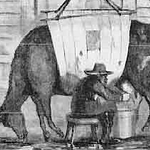The two items that Leigh and Kim feature in As We Eat’s first ever “What’s in Your Pantry?” are considered kitchen staples, but both have fascinating histories in addition to long shelf lives. Although we were both dealing with some very challenging life circumstances, we got together to talk about vinegar and cake flour.
In the debut episode of What’s in Your Pantry episode, Kim and Leigh talk about two items that sit on their pantry shelves, one that was used as a loophole to bootleg during Prohibition and another that helped a mid-west baker win $25,000.00.
Vinegar
Chances are good that you actually have several different kinds of vinegar – white, apple, red wine, rice, etc. For example, Leigh discovered vinegars from all corners of the world in her parents’ pantry.
Vinegar in History
In Vinegar, The User-friendly Standard Text Reference and Guide to Appreciating Making and Enjoying Vinegar, Lawrence J. Diggs writes,
“Think for a moment. What other substance can you name that can be found on the shelves of kitchens all over the world in small villages, as well as large cities? What else can be used almost irrespective of culture or religious belief as food, medicine, beauty aid, cleaner and preservative. And finally, what other substance with all its uses, complexities and varieties can be simply, safely, economically made at home? I know of none except vinegar.”
Likely a result of winemaking gone bad, the word vinegar is old French meaning sour wine. We especially appreciated the irony of something that was supposed to be consumable as a drink ended up non-consumable as a drink but had a profound impact on how we cook and eat.
Vinegar itself has actually been around since the fifth century BC.
There are written records of Babylonians using date vinegar as a preservative and a condiment. In 400 BCE Hippocrates prescribed vinegar as a curative, as well as a preventative. 3000 years ago, Helen of Troy bathed in vinegar daily to preserve her beauty.
If it wasn’t for vinegar perhaps Hannibal couldn’t have attacked Italy. When Hannibal was marching over the Alps to attack Italy, his elephants couldn’t make it through some of the paths, so the soldiers would cover these big boulders with wood that was really high in pitch. They’d set them on fire and then they would pour barrels of vinegar over the fire to create an explosive effect that cracked the boulders enough that the soldiers could clear the paths.
Shanxi is one of the most important regions in China that has been producing Shanxi vinegar for over 2000 years. Legend has it that when a father was looking for a suitable man to marry his daughter, not only would he look and consider the family history and finances, they would require the young man to have a large urn of Shanxi vinegar to be used in the household economy.
Finally, during the American Prohibition, vinegar companies were excluded from not being able to purchase alcohol, and the loopholes were exploited by bootleggers to sell alcohol in the black market. Resultantly, alcohol sold to vinegar makers had to be mixed with 5% ethyl acetate, which is fine for vinegar making, but not so good for wine consumption.
Sour Notes from Sweet Sources
Next we touch on the various fruits and foods that flavor the vinegars we use.
Apple cider vinegar, which is made from cider or apple must, is the one that plays a significant role in folk remedies.
Balsamic vinegar is made from white grapes from Trebbiano mostly, and slowly aged in wooden casks.
Malt vinegar is made from germinated grain that is also used to make ales. It’s typically used for pickling, especially pickled walnuts – a very very English treat – although what we most likely think of when we think of malt vinegar is fish and chips.
Rice vinegar, most popular in East and Southeast Asian cuisines, is aged, filtered rice wine, which is sake. It’s used in stir fries, quick pickles, over salads, and of course in sushi.
Wine vinegars are most typically associated with the Mediterranean countries and central Europe. Red wines are typically used in dressing, sauces, pickling, slow cooking and white wine is used to bring out the sweetness in fruits, especially strawberries and melons.
And there’s all specialty vinegars made from coconut, cane, fruit, raisin date, and honey beer.
Vinegar Beyond the Kitchen
Vinegar is virtually on everybody’s shelf in every size of town in every country for culinary and medicinal purposes. There are so many folk remedies and treatments that utilize vinegar like clearing up coughs, easing asthma, stopping hiccups, helping heartburn.
Leigh shared some archaic but perhaps questionable folk remedies –
“Ye may purify the waters of the body by sipping a tonic of goodly vinegar, mixed with clear running water. “
“Make the suffering of one who speweth up the food, less grievous by covering the belly with a washcloth well soaked in warm vinegar.”
“Those who sup regularly of the miraculous vinegar will be blessed with a sharp mind for all their lives.”
Finally, we discussed how vinegar has an amazing variety of household uses but culinary or medicinal purposes. You can use vinegar from anything from cleaning drains, brightening your laundry, cleaning pewter, washing windows, cleaning mineral buildup on metal.
Here are a couple that we thought were really fun and very interesting:
“Use vinegar and hay to revitalize iron pans, which have rust spots. Fill the pot with hay, add a quarter of a cup of vinegar and enough water to cover the hay. Boil for one hour, wipe the rust away. Rhubarb can also be substituted for hay.”
“Do a vinegar rinse that will help stop cling and reduce the amount of lint that settles on your clothes.”
CAKE FLOUR
The first thing that really caught Kim’s eye when she opened her pantry was a box of SOFTASILK Super Cake flour.
She bought the cake flour to make “Orange Raisin Cake” for a Recipe Box Roulette, and was determined to follow the handwritten recipe to a T. Previous baking efforts were made with All Purpose flour and sometimes Self-Rising flour and Kim started asking herself – what is the deal with all these types of flour?
FLOUR power
At its most basic, flour is the finest product of the process of bolting or grinding meal from cereal grains like wheat, corn, rye, or spelt. Wheat grains or kernels are composed of three basic elements, endosperm, bran, and germ. To make flour, grains are ground or milled to separate the endosperm from the other portions in varying degrees. A whole wheat flour is going to contain more of all the components of a wheat grain. Whereas white flour of which cake flour is apart will contain less of that.
We discuss how milling dates to at least 10,000 BCE. Humans evolved grinding techniques into two veins. One was larger mortars used by two or more people who pounded the grains with a pestle, and the other was a device by which a top stone grinds against a bottom stone and the flour collects in a hollow.
Flour’s next major development came when humans harnessed wind and water power to keep stones moving. Water-powered mills, the kind we usually see in bucolic, pastoral scenes, were mentioned by Vitruvius in 13 BCE and this technique spread across Western Europe. Wind power started to be utilized sometime around 10,000 AD. Milling we received another technological upgrade with steam power and the steel rollers with early efforts dating to the 1820s in Hungary, followed by additional and somewhat final refinement in Switzerland in 1834.
A bouquet of FLOURS
We then explore how flour itself is classified into several categories based on the hardness of the flour and the protein content, which correlates to formation of gluten, which gives strength and firmness to baked goods.
Bread flour is made from blends of hard wheat flour and contains 12 to 14% (or more) of protein.
All Purpose flour made from a blend of hard and soft wheat has more like a 10 to 12% protein ratio.
Cake flour is made almost entirely of soft wheat, and it’s got a really low percentage of protein at about 9%. And it’s often bleached by chlorination. And that process allows fat to more easily adhere to the starch for better distribution throughout the dough.
Finding cake flour for the Orange Raisin Cake recipe was not difficult, but there wasn’t a lot of brand choice, but Kim did acquire a box of Pillsbury SOFTASSILK. Tracing the history of this particular brand of cake flour proved to be a fun challenge as the search uncovered a complicated tangle of some of America’s best known flour brands – Pillsbury, Betty Crocker, and General Mills.
Kim’s box of cake flour says Pillsbury SOFTASSILK, but SOFTASSILK Super Cake Flour was copyrighted by General Mills circa 1934, probably a little earlier. General Mills also in turn created the Betty Crocker brand circa 1936 and Kim found a Betty Crocker ad for SOFTASSILK that uses this claim:
“Betty Crocker for super cakes. Betty Crocker decided in 1937 that she needed a flour so fine that it was to be just used for baking the perfect cakes.”
How a Betty Crocker via General Mills product became a Pillsbury branded product was unclear, although we found out that General Mills acquired Pillsbury’s assets in 2001.
A FLOUR By any other name…
Curious about the shift from Betty Crocker to Pillsbury – when it happened, why it happened – Kim started researching Pillsbury, a company formed in 1869 by Charles Alford Pillsbury and his uncle John S. Pillsbury.
The company was the second in the United States to use steel rollers for processing grain. And they were also hugely responsible for funding railroad development in Minnesota. Pillsbury also began its long running Pillsbury Bakeoff competition in 1949 where they invited home cooks to submit a signature dish made with Pillsbury flours. In 1950, Lily Wuebel of Redwood City, California won the grand prize of $25,000 with her “Orange Kiss Me Cake” recipe, which is an orange raisin cake.
In using cake flour in our Recipe Box Roulette’s Orange Raisin Cake recipe, Kim realized why bakers would specifically use cake flour – the softer flour with less protein content helped make sure that the cake stayed cake and didn’t turn into orange raisin bread.
Last note for home cooks that may not already be aware: substituting cake and all purpose flour is not a one-to-one ratio. If you don’t have cake flour but you want to make cakes and lighter cakes, use one cup a minus two tablespoons of all purpose flour sifted with two tablespoons of cornstarch as a substitution for each cup of cake flour.
If you are curious about the greater history of America’s flour mills and the fates and fortunes of General Mills, Pillsbury, and Betty Crocker – tune into As We Eat’s Episode 20: Grain Empires: The Wheat Belt, American Innovation, and A Kitchen Confidante.
What’s In Your Pantry Transcript
🎧 Click here for the full, interactive transcript of this episode 🎧
Sources We Found Helpful for this Episode
Books We Think You’ll Enjoy Reading
Flour Water Salt Yeast: The Fundamentals of Artisan Bread and Pizza by Ken Forkish
My Bread: The Revolutionary No-Work, No-Knead Method by Jim Lahey
Recipes You Really Need to Try
Orange Kiss Me Cake – Pillsbury
Red Velvet Cake – Pastry Chef Online
Sherry Lime Vinaigrette – Pook’s Pantry
Vinegar Pie – Pastry Chef Online
Homemade Apple Cider Vinegar – The Prairie Homestead
Episodes We Think You’ll Like
Passover: Deliverance, Bitter Herbs, and Maxwell House Coffee
The Glorious Egg: Symbolism, Tiny Dinosaurs, and Egg Espionage
We would love to connect with you
AsWeEat.com, on Instagram @asweeat, join our new As We Eat community on Facebook, or subscribe to the As We Eat Journal.
Do you have a great idea 💡 for a show topic, a recipe 🥘 that you want to share, or just say “hi”👋🏻? Send us an email at connect@asweeat.com
Review As We Eat on Podchaser or Apple Podcast. We would like to know what you think.
And please subscribe to As We Eat, Going Places. Eric and Leigh will be traveling in their converted van sharing stories of food culture from the road.
Enjoy even more delectable content for just a few dollars. You’ll get access to exclusive content including more more in-depth articles, our Recipe Box Roulette “card” game and help keep our oven lights on!
Thank you for listening to the As We Eat Podcast. This post is public so share it with a friend - or three :)


























Share this post